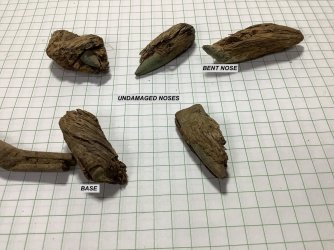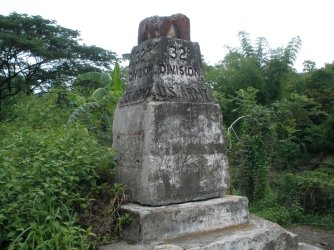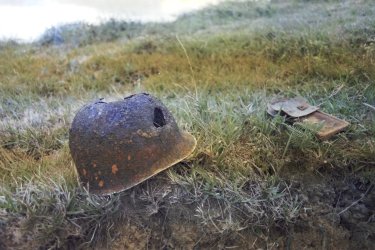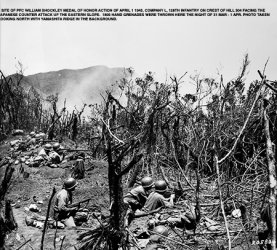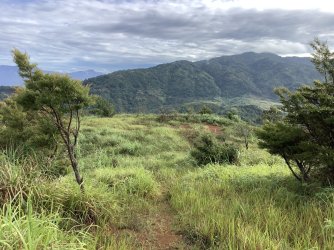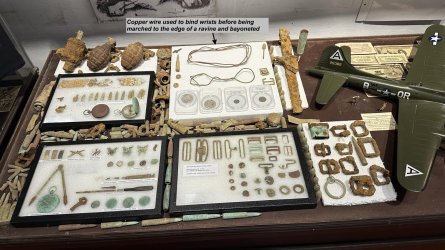I can see a machine gun melting a lead core under heavy use. I was part of a demonstration with an M60 getting hot enough to "run away" from steady firing. The barrel was hot enough to fire a round as the chamber closed without pulling the trigger. Breaking the chain or running out of ammo was the only way to stop firing. I just can't picture a bolt action hunting rifle melting the lead core. I could be wrong.
You are using an out of date browser. It may not display this or other websites correctly.
You should upgrade or use an alternative browser.
You should upgrade or use an alternative browser.
Molten Lead & Jacket Separation
- Thread starter DMM9623
- Start date
 Help Support Long Range Hunting Forum
Help Support Long Range Hunting Forum
epolentna, I appreciate your feedback. Here are a few more bits of information I can include to shed more light.
Under the trees and heavy foliage of these jungles is a heavy ground cover of both rotting and fresh fallen vegetation. Plants, leaves, rotting wood, etc... There is no exposed earth or sand. This battle occurred in April which is at the end of the hot/dry season. Even so, this layer of ground cover remains damp year around. This is due to the high humidity and 100% cover from sunlight. Any molten led would not have burned through to contact earth or sand.
I estimate that 98% of the recovered bullets were damaged from ricochet. The remaining 2% of undamaged bullets would have directly struck and were imbedded in trees or came to rest without contacting a tree or an object while in flight. I don't believe that the behaviors of a tumbling ricochet can be compared to a bullet striking a target backstop. The physics and dynamics of the two differ drastically.
I believe image 4 shows shapes of lead core that had been molten and re-hardened while still in flight or after coming to rest.
I'm seeing hundreds of smaller fragments of lead that I'm not picking up. There's just too much of it.
Many bullets were split at the cannelure providing an opportunity for lead to be ejected from each open end. Many others have multiple hits (a bent nose as well as damage to the center or base) where the bullet ricocheted off of an object and began tumbling and striking other objects. The centrifugal force of this hi-speed tumbling would have ejected molten lead from the open base.
Note that all of the historical accounts of the battle make mention the numerous tall hardwood trees. I assume these were responsible for the majority of ricochets. Foot note on the trees, I have a few bullets still embedded in preserved wood. I assume this was made possible by the preserving properties of the Cu based jacket. Note that these appear to be undamaged and have been verified to be Ball Rounds by magnet test. This raises another question on why these did not pancake or disintegrate. The trees must have been very soft. See photo.
The 30.06 cartridge (bullet) had three iterations, the M1906, M1 and M2. As the designs progressed, the period U.S. Army manuals on small arms ammo state concerns on both core and jacket stability. This was in the context of developing the best alloys to use to prevent melting cores or jacket separation.
Under the trees and heavy foliage of these jungles is a heavy ground cover of both rotting and fresh fallen vegetation. Plants, leaves, rotting wood, etc... There is no exposed earth or sand. This battle occurred in April which is at the end of the hot/dry season. Even so, this layer of ground cover remains damp year around. This is due to the high humidity and 100% cover from sunlight. Any molten led would not have burned through to contact earth or sand.
I estimate that 98% of the recovered bullets were damaged from ricochet. The remaining 2% of undamaged bullets would have directly struck and were imbedded in trees or came to rest without contacting a tree or an object while in flight. I don't believe that the behaviors of a tumbling ricochet can be compared to a bullet striking a target backstop. The physics and dynamics of the two differ drastically.
I believe image 4 shows shapes of lead core that had been molten and re-hardened while still in flight or after coming to rest.
I'm seeing hundreds of smaller fragments of lead that I'm not picking up. There's just too much of it.
Many bullets were split at the cannelure providing an opportunity for lead to be ejected from each open end. Many others have multiple hits (a bent nose as well as damage to the center or base) where the bullet ricocheted off of an object and began tumbling and striking other objects. The centrifugal force of this hi-speed tumbling would have ejected molten lead from the open base.
Note that all of the historical accounts of the battle make mention the numerous tall hardwood trees. I assume these were responsible for the majority of ricochets. Foot note on the trees, I have a few bullets still embedded in preserved wood. I assume this was made possible by the preserving properties of the Cu based jacket. Note that these appear to be undamaged and have been verified to be Ball Rounds by magnet test. This raises another question on why these did not pancake or disintegrate. The trees must have been very soft. See photo.
The 30.06 cartridge (bullet) had three iterations, the M1906, M1 and M2. As the designs progressed, the period U.S. Army manuals on small arms ammo state concerns on both core and jacket stability. This was in the context of developing the best alloys to use to prevent melting cores or jacket separation.
Attachments
7Rum Slayer
Well-Known Member
Very interesting to say the least, thanks for the photos and the research. Cheers, Jason
Rates of Fire:
M1903 10 - 15 Rounds per minute
M1 Garand 40 - 50
M1919 400 - 500
Agree on the M1903.
Under continual fire for extended periods the Garand would get quite hot.
I don't know how much of an affect heat transfer from barrel to core has on core temperatures. It's only one of a few factors, two others being aerodynaimc heating and friction. Copper is an excellent thermo-conductor, second only to silver and it's in direct contact with the boundary layer.
M1903 10 - 15 Rounds per minute
M1 Garand 40 - 50
M1919 400 - 500
Agree on the M1903.
Under continual fire for extended periods the Garand would get quite hot.
I don't know how much of an affect heat transfer from barrel to core has on core temperatures. It's only one of a few factors, two others being aerodynaimc heating and friction. Copper is an excellent thermo-conductor, second only to silver and it's in direct contact with the boundary layer.
JustMe2
Well-Known Member
The remaining 2% of undamaged bullets would have directly struck and were imbedded in trees or came to rest without contacting a tree or an object while in flight.
Thanks for describing this battle area, however, saying 2% didn't hit an object is absolutely false. Gravity ensures every bullet impacted the ground which is an object.
You can't draw any conclusions about these bullets except maybe those recovered from trees. You don't have any idea if these bullets passed through vegetation, human bodies, helmets, bushes, dirt berm, etc. Since this battle area was densely vegetated, I can guarantee solders were firing their rifles at less than a 20 degree elevation angle because the enemy was on the ground probably crawling, not in the trees. Soldiers are not going to be aiming at tree tops. Consequently, it can be confidently concluded that 100% of those bullets hit something at high velocity, if nothing else skipping off the ground. Therefore, every bullet jacket was damaged to some extent before coming to rest.
epoletna
Well-Known Member
There are several pieces of lead that indeed appear to have melted and re-hardened. I still have some questions I don't feel like I have answers to.
Let's suppose a bullet is leaving the muzzle with a molten lump of lead in the rear (military ammo being open at the base). The lead flies along with the copper until they hit something, at which time the copper would be stopped abruptly. If the lead is totally melted, it might splash out at that time. Would it stay together, or be sprayed out of the cup? If it stays in the cup, it would deform but fill the cup as much as possible before splashing or spraying out. I think if the lead remains molten for a half a second or so, it would be dispersed enough that you would not find any traces of it. There are circumstances under which the lead might not splash or spray, like if it penetrates an inch or two into a tree and the lead would stay in the "wound channel" in the tree.
But I have to say I remain unconvinced that you have demonstrated a significant amount of melting lead, and the actual scenario under which it might happen sounds pretty speculative. I know a significant amount of testing was done during WWII at Aberdeen Proving Grounds, where all manner of small arms were fired under various circumstances. I have read some of those reports, and don't remember ever seeing anything about lead cores melting. Maybe they saw it and didn't document it, but they sure documented other stuff that seemed to be of marginal importance to the subject of their tests.
Let's suppose a bullet is leaving the muzzle with a molten lump of lead in the rear (military ammo being open at the base). The lead flies along with the copper until they hit something, at which time the copper would be stopped abruptly. If the lead is totally melted, it might splash out at that time. Would it stay together, or be sprayed out of the cup? If it stays in the cup, it would deform but fill the cup as much as possible before splashing or spraying out. I think if the lead remains molten for a half a second or so, it would be dispersed enough that you would not find any traces of it. There are circumstances under which the lead might not splash or spray, like if it penetrates an inch or two into a tree and the lead would stay in the "wound channel" in the tree.
But I have to say I remain unconvinced that you have demonstrated a significant amount of melting lead, and the actual scenario under which it might happen sounds pretty speculative. I know a significant amount of testing was done during WWII at Aberdeen Proving Grounds, where all manner of small arms were fired under various circumstances. I have read some of those reports, and don't remember ever seeing anything about lead cores melting. Maybe they saw it and didn't document it, but they sure documented other stuff that seemed to be of marginal importance to the subject of their tests.
Where do you think those little lead split shot fishing weights come from Red?I remember that old thread. If it were true the old Nosler Partition bullets would have left lead in the barrel and never worked as described. They had exposed lead at the rear of the bullet.
Lazy bunny rabbits that finally learned to get the lead out of theirWhere do you think those little lead split shot fishing weights come from Red?
cohunt
Well-Known Member
Has the battlefield seen any fires in the last 80 years?
Mikecr
Well-Known Member
There are many discussions out there about bullet blowups and various in-flight failures.
All from too much heat. A combination direct heat applied and barrel friction.
Generally cured with thicker bullet jackets, new barrel, slower twist, smaller cartridge.
Berger did a lot of testing to determine customer cause of VLD blowups.
Their cure was thicker jacket 'target' VLDs, but hunters blowup more bullets for sure.
It never made sense to merchandise the original thin jacket VLDs as 'hunting' VLDs.
They put out pics and videos that I can't get to and show from this work computer. But you might search in their direction.
As far as cores spinning within jackets as a normal,, I doubt that.
Engraving grabs cores before they can heat up. The lead is spun up with the jacket, and there is nothing to change spinning speed between the two -until jacket failure.
The jacket fails in-flight when enough lead did heat to liquid, and imparting enough outward centrifugal forces to cause it.
Twist, area, heat.
All from too much heat. A combination direct heat applied and barrel friction.
Generally cured with thicker bullet jackets, new barrel, slower twist, smaller cartridge.
Berger did a lot of testing to determine customer cause of VLD blowups.
Their cure was thicker jacket 'target' VLDs, but hunters blowup more bullets for sure.
It never made sense to merchandise the original thin jacket VLDs as 'hunting' VLDs.
They put out pics and videos that I can't get to and show from this work computer. But you might search in their direction.
As far as cores spinning within jackets as a normal,, I doubt that.
Engraving grabs cores before they can heat up. The lead is spun up with the jacket, and there is nothing to change spinning speed between the two -until jacket failure.
The jacket fails in-flight when enough lead did heat to liquid, and imparting enough outward centrifugal forces to cause it.
Twist, area, heat.
Gary in MD
Well-Known Member
Sooooo
Nothing proven. Nice little hobby, picking up spent bullets out of the dirt, enjoy.
Nothing proven. Nice little hobby, picking up spent bullets out of the dirt, enjoy.
Gary in MD, It's not a hobby. What I'm doing is recovering relics from fields and jungles where American Soldiers died in battle. It's much more than just bullets. Everything goes to museums where thousands of people go to keep the memory alive. On a typical day, I spend about 8 hours either in the hot humid jungle tripping and cutting through foliage or exposed to the tropical sun when in the fields. The slopes are steep and most everything is buried so add to that the need to swing a metal detector and dig each recovery while trying not to slide or fall. Now add the fact that I'm 65 and still committed to go through this daily hell with the sole intention of honoring our fallen. Note that I also search for locations where our troops were massacred and have located one from which I recovered evidence of what occurred. What a waste of your time writing a reply that contributes zero to the discussion. I'm attaching some photos that may help adjust your attitude....or not. .....
Attachments
Gary in MD
Well-Known Member
Point taken
Being that this is a hunting forum, please post some pics of some of your hunting photos or some bullets that you have recovered from game taken.
Have a good day
Being that this is a hunting forum, please post some pics of some of your hunting photos or some bullets that you have recovered from game taken.
Have a good day
Similar threads
- Replies
- 84
- Views
- 8K
